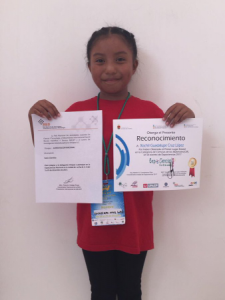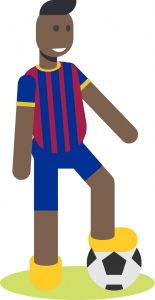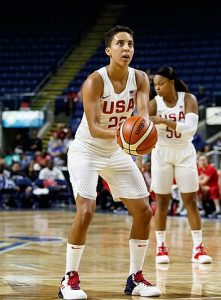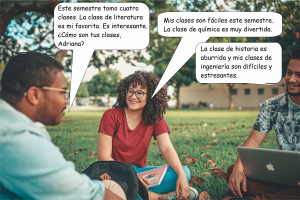7 Lesson 1C
1. Conversar. Take turns asking your classmate the following questions. Use the information from the table below to respond. It is not necessary to respond using complete sentences.
Modelo:
| Estudiante A | Estudiante B |
| ¿Quién es Ellie? | Es nadadora paralímpica. ¿Cuántos años tiene Ellie? |
| 20 años. |
| Ellie Challis | Xochitl Cruz | Ansu Fati Vieira | Layshia Clarendon | |
 |
 |
 |
 |
|
| Nacionalidad | Es británica | Es mexicana | Es de Guinea-Bisáu | Es estadounidense |
| Edad (fecha de nacimiento) | Tiene 20 años (2004) | (2013) | (2002) | (1991) |
| Profesión | Es nadadora paralímpica y tiene una medalla de bronce | Estudia en Chiapas y es científica | Es futbolista profesional | Es jugadore de baloncesto |
| Teléfono: | 447-555-4560 | +52 900-777-8910 | 693-246-8357 | 612-547-8545 |
| Correo electrónico: | ellie@britain.com | xochitl@gmail.com |
ansufati@barcelona.com | layshia@lynx.com |
- ¿Quién es Ellie?
- ¿Cuántos años tiene Xochitl (pronounced: So-chee-tel)?
- ¿Cuántos años tiene Ansu Fati Vieira?
- ¿Quién estudia en Chiapas?
- ¿Cuál es la profesión de Layshia?
- ¿Cuál es el número de teléfono de Ellie?
- ¿Quién tiene una medalla de bronce?
- ¿Cuál es el correo electrónico de Ansu Fati?
2. Emparejar. Match the picture with the correct university class.
3. Decidir. Read the conversation that these university students are having about their classes. Then read the statements and decide if they are true (Cierto) or false (Falso).
 From left to right: David, Adriana, and Santiago.
From left to right: David, Adriana, and Santiago.
¿Cómo está María?
¿Dónde trabaja María?
¿Cuál es la profesión de Juan?
5. Crear. Combine the classes and adjectives from the columns below to create your own sentences. Take turns sharing them with a partner and check that your nouns and adjectives agree in gender and number. Remember that you are talking about “La clase de…” so all of your adjectives must be feminine when possible.
Modelo:
| Estudiante A | Estudiante B |
| La clase de retórica es estresante. | La clase de biología es divertida. |
| Las clases | Los adjetivos |
| arte | aburrida |
| cinematografía | difícil |
| contabilidad | divertida |
| educación | estresante |
| español | fácil |
| historia | interesante |
| literatura | mi favorita |
| matemáticas | |
| negocios | |
| psicología |
6. Entrevistar. Interview your classmates to ask their opinions about various areas of study. See what sorts of things they think are interesting, what they are bored by, and what are their favorites.
Modelo:
| Estudiante A | Estudiante B |
| ¿Cómo es la psicología? | La psicología es estresante y difícil. Y para ti, ¿cómo es la contabilidad? |
7. Escribir. You are going to write your own mini biography.
Paso 1. Write a short biographical paragraph. Indicate your name, your place of origin, where you go to school, your age, your cell phone number, and your favorite university class.
Modelo:
Me llamo Peter. Soy de Los Ángeles. Estudio en la Universidad de Iowa. Tengo 22 años. Mi número de teléfono es 555-666-7878. Mi clase favorita es la clase de español.
Paso 2. With a partner, exchange your biographies and read them.
8. Escribir. Create an artistic biopoema. State your name, two to three adjectives that describe you, and your favorite course subject.
Modelo:
| Juan Castillo |
| Divertido |
| Interesante |
| Espaňol |
9. Completar. Read the following paragraph and fill in the blanks with the correct conjugation of “estudiar” or “trabajar” based on the context.
10. Completar. Fill out the verb charts below for the verbs “trabajar” and “estudiar”.
| Subject pronouns |
The verb TRABAJAR |
| Yo | … |
| Tú | … |
| Usted/Él/Ella | … |
| Nosotros/as | … |
| Vosotros/as | … |
| Ustedes/Ellos/Ellas | … |
| Subject pronouns |
The verb ESTUDIAR |
| Yo | … |
| Tú | … |
| Usted/Él/Ella | … |
| Nosotros/as | … |
| Vosotros/as | … |
| Ustedes/Ellos/Ellas | … |
11. Escuchar. Listen to the following audio clips.
Erick:
Lara:
Oriette:
Paso 1. Look at the table below and circle the correct information in each column based on what you hear in the audio clips.
| Name | Verb | Frequency |
| Erick | Trabajar / Estudiar | Nunca / A veces / Todos los días |
| Lara | Trabajar / Estudiar | Nunca / A veces / Siempre |
| Oriette | Trabajar / Estudiar | Nunca / A veces / Siempre |
Paso 2. Write a sentence similar to what you just heard about yourself.
12. Conversar. Take turns interviewing your classmate about their jobs and their studies. Be sure to take notes on their answers.
- ¿Qué estudias?
- ¿Con qué frecuencia estudias en la biblioteca (the library)?
- ¿Dónde trabajas?
- ¿Con qué frecuencia trabajas?
- ¿Cuál es tu clase favorita? ¿Cómo es la clase?
13. Conversar. Take turns playing “dos verdades y una mentira” with your partner about your jobs and studies. Your partner will tell you two truths and one lie in Spanish. You have to pick which one is the lie.
Modelo:
| Estudiante A | Estudiante B |
| Trabajo en McDonalds todos los fines de semana. No trabajo. Estudio inglés. |
¿”Trabajo en McDonalds” es la mentira? |
| ¡Correcto! Es la mentira. |
14. Investigar. Talk to as many classmates as you can and collect the following information: Name, where they work, and what they study. Then write at least three sentences based on the information you collected. Do you and any of your classmates study the same thing or work at the same place?
Modelo:
Rachel estudia historia.
Sofía y yo estudiamos matemáticas.

